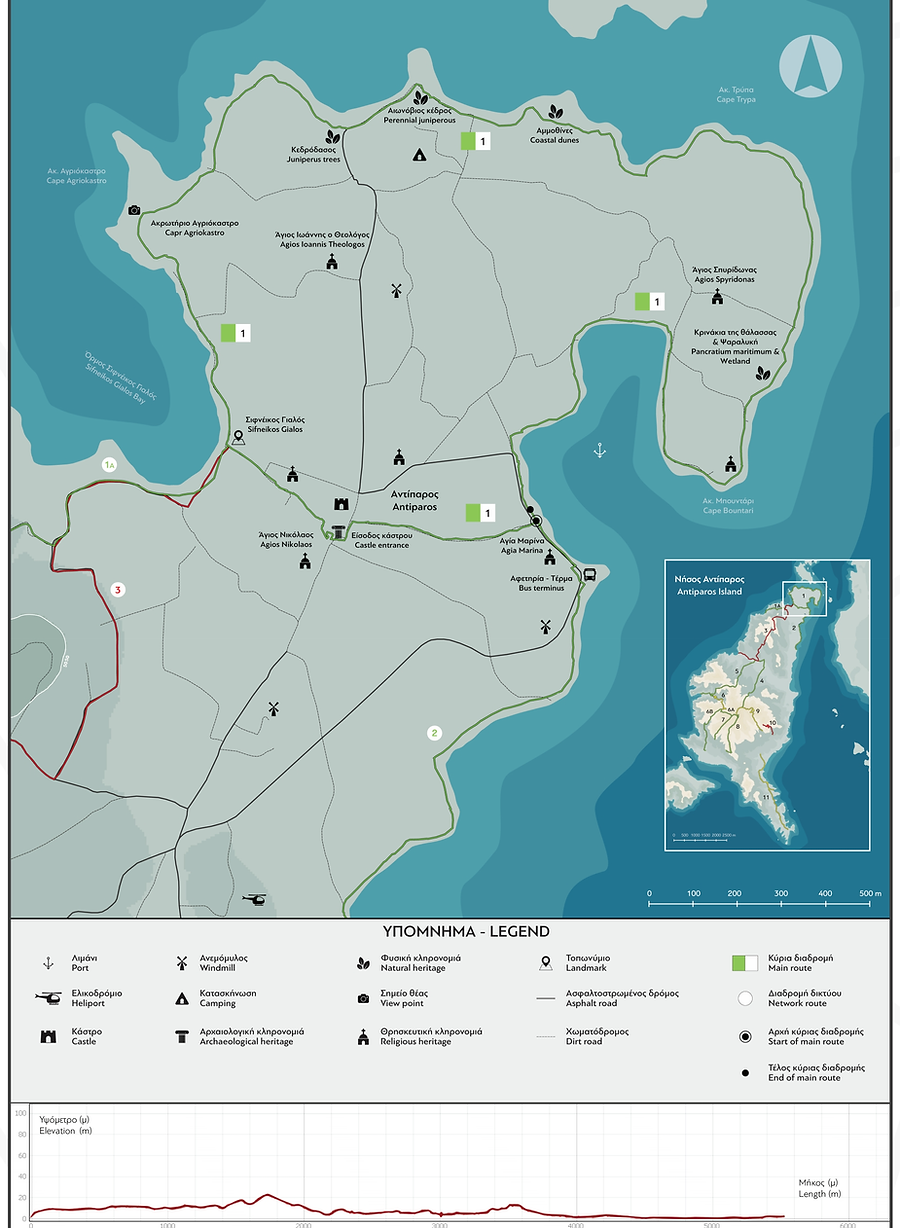«OLIAROS»

 Main Market |  EXIT FROM THE TRADITIONAL SETTLEMENT |  CASTLE ENTRANCE |
|---|---|---|
 SIFNEIKOS GIALOS |  CAPE AGRIOKASTRO |  CEDAR FOREST |
 SAND DUNES |  SUNSET |  EASTERN CEDAR |
 SAND DAFFODILS |
Useful information: It can be combined with Route 1A so as the visitor could have an overall picture of the island of Antiparos.
SHORT DESCRIPTION
This circular Route is kind of an introductory hiking activity included in ANTIPAROS ROUTES network and can be done as an afternoon walk as well. It is suitable for people of all ages regardless their physical condition. If you wish to enjoy the sunset, it is recommended to follow the reverse route from the one described below.
After passing the central paved road of Chorio, you will also pass the so-called “katastegi” (a wooden construction that connects two residences at the first-floor level) directing towards Sifneikos Gialos. Following a northward direction to reach Agriokastro point, the path evolves over the homonymous cape. Directing eastwards, you will encounter the sensitive cedar ecosystem and the King Cedar- a tree dated hundreds of years back. You will also come across the coastal dunes’ habitat, and the sand daffodils as well. The northern part of the island used to be full of cedars, hence Antiparos’ ancient name was “Oliaros”, a word of Phoenician origin probably meaning “woody place”.
POINTS OF INTEREST
SIFNEIKOS GIALOS
At the opposite side of the Castle, the bay of Sifneikos Gialos is used as a safe anchoring point. It is named after the island of Sifnos since it is located across from Antiparos. Watching the sunset from this place is a must-do when visiting Antiparos!
AGRIOKASTRO
Directing to the northwestern point of Antiparos, you will reach Agriokastro which is right across from the islet Kato Fyro (Diplo). This is the place where the ruins of the ancient settlement of Agriokastro lie; pottery finds dated on the end of first half of the 2nd millennium BC suggest that this settlement flourished at that time. Agriokastro is considered to be a significant prehistoric settlement in the Cycladic region, equivalent important to the Akrotiri of Thira, the Filakopi of Milos, and the Agia Eirini of Kea.
CENTENARIAN CEDAR TREE
King Cedar is in Antiparos! Located at the northern part of the island, King Cedar is hundreds of years old and its height is really breathtaking. It constitutes a landmark of the cedar forest which once formed dense clusters in the northern part of Antiparos; hence Antiparos’ ancient name was “Oliaros”, a word of Phoenician origin probably meaning “woody place”.
CEDAR FOREST
The Greek name of the Juniperus genus is “arkefthi”. The names “cedra” or “cedroi” (in plural) is more common but they should not be confused with the other species of Cedrus genus (C. libani and C.atlantica). In Greece, these species are not indigenous and have been imported mainly for decorative purposes. The coastal cedar species are submitted to hard pressure due to human activities and are in danger mainly because of the uncontrolled tourism development. Another major factor contributing to the pressure these species face is visitors’ lack of awareness. The fact that cedars’ natural regeneration is really slow and when combined with the climate change, intensifies the need for urgent action in order to protect and preserve this sensitive ecosystem.
SAND DUNES
A rare habitat of great aesthetic value in Antiparos is the one including coastal sand dunes along with cedar species. The roots of the trees are expanded to a length that is at least twice their height, forming a dense grid made of the trees’ trunk. This grid restrains sand, thus forming sand dunes. The aforementioned habitat belongs to the list of “priority habitats” which means that it is in danger to be extinct. Therefore, we are all responsible for its preservation!
SAND DAFFODILS
A stunning amaryllis inspired once an ancient artist which depicted it on the frescos of the prehistoric town of Akrotiri in Santorini. It is also known as sand daffodil (Pancratium maritimum). The word Pancratium has its origin in two Greek words παν and κρατύς = powerful, strong. Although it is an extremely resistant plant since it manages to blossom at a sandy ground, it is in danger of extinction due to the imprudent tourism development taking place at the Mediterranean sandy beaches!


